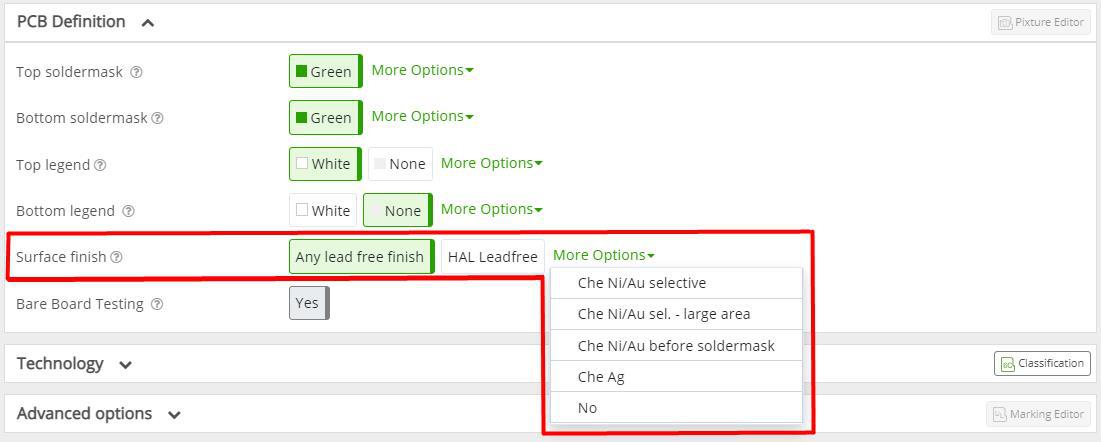See also:
Surface Finishes on Printed Circuit Boards
Choosing the right Surface Finish for your PCB is as important as choosing a manufacturer to make the PCB, use the wrong Surface Finish and you may have downstream issues during assembly or longer-term reliability issues.
The Surface finish is a protection against the elements, in short it is designed to protect soldering pads and contact pads from oxidation or becoming contaminated.
Without a Surface finish the exposed copper would oxidise, thus making the soldering of components difficult and any electrical contact pads such as edge connectors would have a poor electrical connection.
Since all finishes have advantages and disadvantages, it is important to select the right one based on the PCB design, storage, functionality and how they will be handled during assembly.
The different finishes we offer are Lead-free Hot Air Surface Levelling (HAL), Electroless Nickel/Immersion Gold (ENIG) and Immersion Silver (ImAg). All of these are Lead-free and can be used for RoHS designs as well as in a SnPb assembly.
It is recommended that edge connectors have an Electroplated Hard Gold (Ni/Au) surface finish.
Any Lead Free
If you don’t select a finish then your PCBs will be produced on a panel with either a Lead-free HAL, chem. Ag or chem. NiAu. The finish will be defined by other PCBs on the same panel.
However, if your design includes fine pitch pads this will automatically be changed to ENIG finish.
HAL Leadfree (Hot Air Surface Levelling)
The Lead-free HAL (or HASL as it is also known) finish provides the PCB with the highest level of solderability. It also provides the level of robustness with regards to multi-step assembly and storage at a reasonable price.
On the other hand, the HAL process requires the submerging of the complete PCB in liquid solder and thus is responsible for extra thermal load on the PCB.
For that reason, it isn’t the best choice if your board requires small via holes or the board exceeds a normal thickness (when the aspect ratio is high).
Another aspect of this surface finish is less flat than other surface finishes, although we try to achieve the flattest surface possible. The varying amount of solder present on the component solder-pads may also make this finish less suitable for components with small and fine pitch pads.
Chemical Ni/Au (Electroless Nickle/Immersion Gold or ENIG)
Many customers choose this surface finish as it offers a flat surface, good solderability and acceptable shelf life.
It is a well-established surface finish for PCBs having been introduced even before the requirement for Lead-free assembly. However, the ENIG process is complicated with a higher risk of defects (skip plating, black pad or interface embrittlement).
When using ENIG, the solder-joint is formed between the solder and the Ni layer of the NiAu surface, not with the underlying Cu. The Au is completely dissolved into the solder joint.
Also this interface seems to be considerably more brittle than with the HAL (SnCu) interface and it is not recommended for applications which are subject to shocks, bending or strong vibrations.
One final point, it is the most expensive surface finish offered, however, for some applications, like key pads or wire bonding, it is the best solution.
Chemical Ni/Au Large Area (Electroless Nickle/Immersion Gold or ENIG)
Any copper area that is not covered by Soldermask and is ≥40% of the total copper area of an outer layer is classed as a larger area.
These will increase the cost of the PCB.
Chemical Ni/Au before Soldermask (Electroless Nickle/Immersion Gold or ENIG)
If this option is selected then the ENIG surface finish is applied before the Soldermask and all copper will be covered with ENIG.
Chemical Ag (Immersion Silver)
This surface finish is often a bone of contention, some love this finish, and some hate it.
It offers a flat surface with very good solderability. The solder-joint is created with the underlying Cu, since the Ag is dissolved during soldering process.
It all sounds good, but the ImAg is susceptible to sulphur dioxide (SO²) which tarnishes the surface and creates the AgS² layer. This layer affects adversely the solderability.
To avoid this tarnish, we pack the PCB’s in silver saving paper and hermetically sealed packing to avoid moisture and atmosphere SO² coming in.
In case of multi-step assembly, the partially assembled PCBs should be stored in a sulphur-free atmosphere.
Depending upon the storage conditions the shelf life of this surface finish maybe an issue.
Other Available Surface Finishes
Hard Gold for Edge Connectors
Due to the need for edge connectors pads to be resistant to abrasion we recommend that these have an electroplated NiAu (Hard Gold) surface finish.
This finish is processed in a specialised bath that is only used for these type of connectors.
It is not possible to have this hard gold processed on other locations of the PCB.
Carbon
Carbon combines a high mechanical strength with a good electrical conductivity and can often be used as a substitute for gold on contacts.
It is printed directly on the Cu and used for switch contacts, foil keyboards and can enable the creation of cross-over conductors. It is resistant to HAL and soldering processes without showing practically any change in resistance.







